
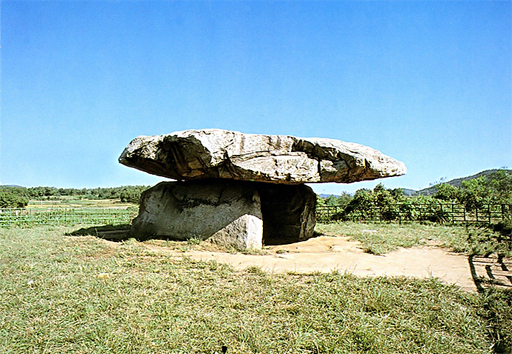
B . Korean History
Ancient chosun
It is not clear that when exactly human being started to dwell on Korean peninsula. According to the present archeological study, human being started to live in Korean peninsula around seven hundred thousand years ago. The relics of it are found in many places such as Seockjang-li at Gongju. They lived their lives mainly by fishing and hunting and collecting plants and stuffs in mountains and fields.
It is considered that Neolithic man came to the peninsula around 6000 B.C. They were using grinding stone implement and crokery. The most representative crokery of this age is comb teeth patterned crokery. The Neolithic man live by the river or seashore doing fishing or hunting and later became agrarian. They were close to old-Asian unlike Chinese. Unlike the Paleolithic man, Neolithic man were able to keep their pedigree to form Korean people, later mixed with bronze age man to become Korean.
Around 10 BC Korean were starting to use Bronze ware. The use of bronze casting weapon and agricultural tools led to improve fighting power and agricultural productivity. Cultivating rice and other grains made the society to transform into agrarian society. In this period, we find the earliest form of state structure in the history of the Korean people, as walled-town states emerged. These were earthen fortifications built on hillside plateaus which controlled the modest agricultural population that farmed the narrow plains which lay beyond them.
Over a period of time, confederated kingdoms, societies with articulated political structures, developed around the walled-town states. By around 400BC, these states had advanced to the point where their existence was known even in China.
Ancient Chosun established itself in the basins of the Liao and Taedong-gang rivers. It had combined with other walled-town states to form a large confederation, the head of which came to be designated as king. In the light of assertions by the state of Yen in North China to the effect that Ancient Chosun was arrogant and cruel, it may be inferred that it was regarded as a formidable power in the region.
However, by the end of the 4th century BC Ancient Chosun began to encounter severe pressure form Yen and entered a period of gradual decline which lasted about a century. During this time it fell successively under the dominion of the Ch'in empire and Han dynasty. As a result, refugee populations migrated eastwards. The end of the kingdom was near and sometime between 194 and 180 BC Wiman, a man of Ancient Chosun who had been in the service of Yen, drove King of Ancient Chosun from his throne and assumed the kingship. The subsequent Kingdom was called Wiman Chosun. Due to frequent contact with the Chinese states, it bore some of the hallmarks fo Chinese society, but it was basically a kingdom founded upon Ancient Chosun. Wiman Chosun was powerful and ambitious. However, attacked by han, Wiman Chosun fought off the invaders for over a year but eventually fell in 108BC, mainly because of defections and internal dissension. Han promptly established four command posts in and around the Korean peninsula. These were Lo-lang, Chen-fan, Lin-t'un and hsuan-t'u. Chinese control over these areas lasted 400 years, until the command posts began to be pressured by the growing states of Koguryo and Paekche. The Korean people of the area found themselves under fairly benevolent rule as the Chinese allowed political freedom but exercised control in other ways, commanding labour service and transmitting Chinese law. During this period, a great deal of Chinese culture was assimilated by the inhabitants of the peninsula, an on-going event which marked the beginning of many centuries of cultural borrowing from the Chinese. In this period, there were Puyeo, Koguryo, Ok-geo at Northern part of Korea and Samhan(Mahan, Chinhan and Pyonhan) at South.
the Paleolithic man, Neolithic man were able to keep their pedigree to form Korean people, later mixed with bronze age man to become Korean.
Around 10 BC Korean were starting to use Bronze ware. The use of bronze casting weapon and agricultural tools led to improve fighting power and agricultural productivity. Cultivating rice and other grains made the society to transform into agrarian society. In this period, we find the earliest form of state structure in the history of the Korean people, as walled-town states emerged. These were earthen fortifications built on hillside plateaus which controlled the modest agricultural population that farmed the narrow plains which lay beyond them.
Over a period of time, confederated kingdoms, societies with articulated political structures, developed around the walled-town states. By around 400BC, these states had advanced to the point where their existence was known even in China.
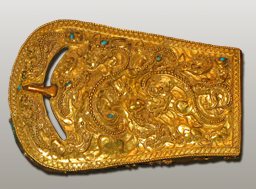
Ancient Chosun established itself in the basins of the Liao and Taedong-gang rivers. It had combined with other walled-town states to form a large confederation, the head of which came to be designated as king. In the light of assertions by the state of Yen in North China to the effect that Ancient Chosun was arrogant and cruel, it may be inferred that it was regarded as a formidable power in the region.
However, by the end of the 4th century BC Ancient Chosun began to encounter severe pressure form Yen and entered a period of gradual decline which lasted about a century. During this time it fell successively under the dominion of the Ch'in empire and Han dynasty. As a result, refugee populations migrated eastwards. The end of the kingdom was near and sometime between 194 and 180 BC Wiman, a man of Ancient Chosun who had been in the service of Yen, drove King of Ancient Chosun from his throne and assumed the kingship. The subsequent Kingdom was called Wiman Chosun. Due to frequent contact with the Chinese states, it bore some of the hallmarks fo Chinese society, but it was basically a kingdom founded upon Ancient Chosun. Wiman Chosun was powerful and ambitious. However, attacked by han, Wiman Chosun fought off the invaders for over a year but eventually fell in 108BC, mainly because of defections and internal dissension. Han promptly established four command posts in and around the Korean peninsula. These were Lo-lang, Chen-fan, Lin-t'un and hsuan-t'u. Chinese control over these areas lasted 400 years, until the command posts began to be pressured by the growing states of Koguryo and Paekche. The Korean people of the area found themselves under fairly benevolent rule as the Chinese allowed political freedom but exercised control in other ways, commanding labour service and transmitting Chinese law. During this period, a great deal of Chinese culture was assimilated by the inhabitants of the peninsula, an on-going event which marked the beginning of many centuries of cultural borrowing from the Chinese. In this period, there were Puyeo, Koguryo, Ok-geo at Northern part of Korea and Samhan(Mahan, Chinhan and Pyonhan) at South.
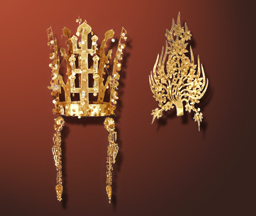
Three Kingdom
In the so-called Three kingdoms period, three principal states emerged to partition the Korean peninsula: Koguryo, Paekche and Shlla. Koguryo was the first to emerge among all. Koguryo had already established itself as a major power in the region, vying with China for control of Manchuria. People of Koguryo had very strong and they were conquering other abut nations.
On the other hand, in the southern part of Han river, Samhan(Mahan, Chinhan and Pyonhan) were established. Rice farming was very advanced in those areas. Byekgoljae at Kimjae is one evidence of reservoir for irrigation.
Paekche was developed by the Han-river out of Mahan 54 nations. Shilla emerged at Kyongju area out of Chin-han 12 nations. There being a large confederated kingdom east of the Naktong-gang River; Kaya.
Koguryo was the most advanced nation among all three. Kyrubu the royal and 5 other tribes are leading the politics. Toward the end of 1st century Koguryo appeared as a conqueror and by the time of Kwanggaeto the great and king Jangsu, it had its very sun. They were enable to establish a large dynasty throughout Manchuria and Korean Peninsula. This can be proved by the tombstone of Kwanggaeto the great at Southern Manchuria.
Paekche was founded by Onjo, the prince of Koguryo, by the Han River area (BC 18). Its national system was completed by 3rd century AD and it became conqueror empire in the period of king Keunchogo(346-375). It expanded its border by conquering Mahan.
Silla was the last to emerge. Silla's throne was taken turn by Jung, Park and Kim dynasty, but since the 17th King Naemool(346-402), Kim monopolized Silla's throne. By the 6th century AD, Silla established its law and promulgated it widely. And they officially authorized the Buddhism. Silla had reached its zenith in the period of King Jinheung(540-576) and commanded the Naktong-gang River and the Han-River area. Also advanced North to Hamkyong Do where Koguryo dominating province. King Jinheung's conquest can be proved by Sunsubi, and this is the foundation of unification of the three nations.
The Three nations each established concentric powered nations centered by its king and established their spiritual foundation by accepting Buddhism. The three nations continued their war to conquer each other. In doing so, they made alliance with each other sometimes between Silla and Paekche, or Koguryo and Paekche.
Silla created the most unique culture among all three nation. Koguryo's arts was grandeur and animated, Paekche's arts showed graceful and refined skill. For Silla's arts, simplicity and harmony are typical characteristics. These culture had been transferred to Japan and influenced ancient Japanese cultural foundation.
Silla, which seized the Han-river, the central part of Korean peninsula, allied with Tang dynasty to destroy Paekche first, then in 668AD invade Koguryo to unify the Korean Peninsular at last. Silla combined all three nations' cultures to develop into national culture tradition. Especially alongside with Buddhism, the arts of Buddhism was flourished to create outstanding Buddhism arts such as Bulkuksa and Suckgulam.
Palhae was established at Manchuria after Koguryo was destroyed. The nation land was mostly that of Koguryo's old land and the ruling class was formed by Koguryo elite. Palhae and Unified Silla were two countries control the Korean peninsular.
The struggle for domination in the late 8 century to the end of 9th century, Shilla completely lost control of the countryside and was largely helpless. This chaos became nation wide civil upspring and local powered lords gathered their power together to found a new nation. Kyonhwon established Later-Paekche and Goongyae established Later-Koguryo. However these three nations were vanished with the establishment of the new nation; Korea.
Korea Dynasty
In 918 AD, Wang Kon took over the power of the state and renamed the state Koryo to give the impression he had formed a new state and moved the capital to Kaesong, where he had the support of a local power base and could form strong ties with other local gentry. In addition, he established close ties with Shilla, with the intention of destroying Kyohwon and securing his position as a successor to Shilla traditions and authority. Such preliminaries over, the hostilities proceeded apace.
In 927, Kyohwon attacked Shilla, killing King Kyongae. Wang Kon took advantage to both attack Later Paekche and be seen as a defender of Shilla. Koryo soon gained the advantage, with victories in 930 and 934. Meanwhile, Later Paekche developed internal problems. In 935 King Kyongsun of Shilla
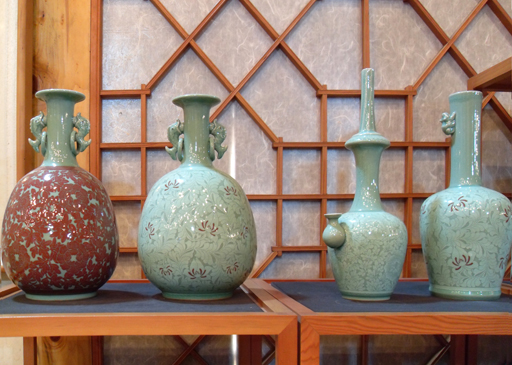
tendered formal surrender to Koryo. Then in 936 Koryo defeated Later Paekche and reunification was
achieved. In effect, the new state of Koryo might be said to have achieved a more complete unification that Shilla because when Palhae fell n 926, large numbers of former Koguryo aristocracy fled to Koryo and this time, Koryo didn't use the power of out side power such as China like Shilla did.
Koryo tried to stabilize the livelihood of people and keep the Northern expanding policy and establish the Buddhism as the state religion.
Koryo(period of Sungjong 981-997) had Confucianism as its political ideology and established centralized government system. Koryo put in order its politics, military system and education system (Kukjakam). Also established state examination for bureaucrat selection to employ government officials who had knowledge based on Confucianism and morality. Because Koryo was Buddhist nation, it appointed learned Buddhist monk as national advisors.
In the early period of Koryo's Buddhism was divided into two different denominations: Sunjong and Kyojong. Euchun (monk) tried to unify these two denominations into one. As Buddhism became prosperous, the complete collection of Buddhist Sutras had been attempted for several times. As education based on Confucianism grew regularized, Chinese literature had been developed and 'Samkuk-Saki' was edited based on Confucianism. Flourishing aristocracy stimulated Koryo's artistic creativeness. One representative form of arts is celadon porcelain-Chungja. Koryo Chungja's beauty lies on its artistic curve, mysterious color and inlaying work. This work of arts was influenced by Song dynasty's porcelain, but Koryo's porcelains were evaluated as excelling that of Song's.
Koryo's military officials had to put up with lower status than civil officials. And a lot of other unfair treatments were accumulated. As a result of such treatment, seething discontent had characterised the military disposition from as early as 1014, when a coup was attempted. In circumstances like these, revolt was inevitable. In the yeas 1170-1196 the locus of power shifted almost continually from one strong man to another, until Ch'oe Chunghon and his brother seized power. The Ch'oe managed to establish, and maintain, order for a period of 60 years, until 1258. In this period Mongolian had invaded Koryo, but Ch'oe's regime resisted them by all means including moving Koryo's capital to Kanghwa. There were no other countries which could resist against the world most fierce army of Mongol (Genghis Kahn's era) but Koryo. However, Koryo had to made humiliating peace with Mongol and Mongolian interfered internal affairs of Koryo. By the time of king Kongmin(1351-1374), Koryo could pull itself out of the interference and restore its territory and independence. In this period, Koryo government tried to re-structure its political, economic, social systems in the power of newly illustrious officials. But this restructuring could not succeed due to the repulsion of nobility and other social-economic problems. Koryo dynasty could not overcome its domestic and foreign problems and finally collapsed to open the new era of Chosun Dynasty.
Toward the end of Koryo dynasty, there was new tendency in thoughts. Buddhism was united by Sunjong into Chokyejong, Sunglihak, imported by Won dynasty, slowly replaced Buddhism as the leading thought of the society.
Koryo invented metal printing type for the first time in the world history. And in the course of cultural exchange with Won, Koryo adopted advanced Arabic astronomy, mathematics and medical science.
Chosun Dynasty 1
Chosun - Part I
In the late period of Koryo, General Yi Sungkye who had defended the invasion of Honkunjuk and Japanese pirate raiders, became to seize the political power by marching his army back from Wihwa Island at the mouth of the Yalu River and conducted a near bloodless coup and established Chosun dynasty at 1392. The establishment of Chosun is not simply the change of the throne but it was drastic change of politics, economy, society, thoughts. Politically, new aristocrats(The two upper classes of Korea) formed ruling power. In terms of economy, number of independent farmer had increased and status of peasant were elevated. Sunglihak (based on human nature and natural laws) became political ideology and rule of everyday life.
The Yalu River and the Dooman River became Chosun's border. Yi dynasty strengthen its royal authority from the start of the period and divided its municipal area into 8 districts to establish centralized nation. Along with political stability, it doubled its arable land compared to Koryo era to stabilize livelihood of people. Yi dynasty could flourish its culture based on those stable conditions. Especially King Sejong's creation of Hunminjungeum (Hangeul) enabled Korean people to have their own letters. Hunminfungeum is one of the most creative and scientific characters in the world. Besides this, in this period, Yi dynasty developed cultural and scientific areas such as agriculture, astronomy, medical science, music etc. It was very helpful for the agriculture that invention of pluviometer for the first time in the world which enable to gauge the rain fall around the country.
There was some change in ruling class of Yi dynasty toward the end of 15 century. The advent of Salim power and its dispute with Hungu power caused the calamity of literati. The Salim, based on local power and grew their political and social power since the beginning of the country, was critical literati party and they seized the political power at last. Even after they grabbed the political power the disruption among them didn't stop and split political party ruled the society. These split political party actually did stimulate politics by criticizing and checking each other in some sense, but they became social vice because they created disorder and huge political disputes.
In the 16th century, Chosun had social stability as an agrarian society, but Japan and China's invasion damaged the country as a whole. In 1592, Japanese invaded Chosun. Chosun was taken by surprise. Japanese fleet invaded Pusan and they could occupy Hanyang (Seoul) in no time. Japanese army invaded northern part of Chosun as well. Huge damage was done to Chosun, but Chosun people could defeat Japanese thanks to people like General Yi sunshin (inventor of turtle ship) and loyal troops. With the help of Myong, which felt the sense of emergency, and local loyal troops Chosun could drive Japanese out of Korean peninsular. Some 30 years later, not even before the wound from the war with Japanese, Yeojin(one of the tribes in Manchus) invaded from the North. In 1627 Manchus invaded with a small force of 30,000men. They quickly advanced well to the south of P'yongyang, whereupon the Chosun government willingly acceded to demand that Chosun would not treaten the Manchu rear during their planned push into China. Having secured this promise the Manchus withdrew. Shortly after the Ch'ing having launched a full-scale invasion. Still anxious about the threat to their rear, they then demanded that Chosun acknowledge Ch'ing suzerainty. Chosun refused to receive the Ch'ing's envoys, Ch'ing decided to remove once and for all the threat from Chosun and invaded a second time in 1636, with a force of 200,000 men. The Chosun forces were soundly beaten. Chosun was forced to pay homage to Ch'ing as a suzerain power.
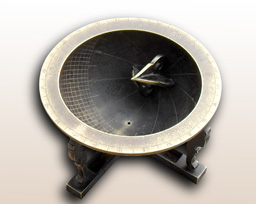
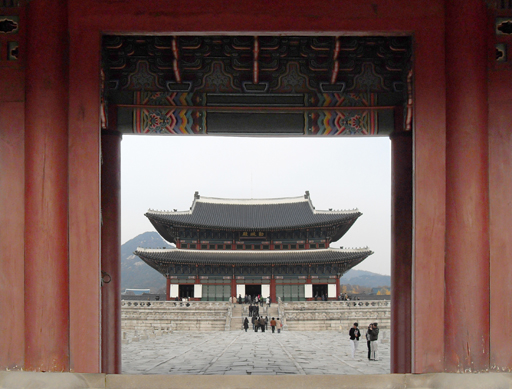
The Yalu River and the Dooman River became Chosun's border. Yi dynasty strengthen its royal authority from the start of the period and divided its municipal area into 8 districts to establish centralized nation. Along with political stability, it doubled its arable land compared to Koryo era to stabilize livelihood of people. Yi dynasty could flourish its culture based on those stable conditions. Especially King Sejong's creation of Hunminjungeum (Hangeul) enabled Korean people to have their own letters. Hunminfungeum is one of the most creative and scientific characters in the world. Besides this, in this period, Yi dynasty developed cultural and scientific areas such as agriculture, astronomy, medical science, music etc. It was very helpful for the agriculture that invention of pluviometer for the first time in the world which enable to gauge the rain fall around the country.
There was some change in ruling class of Yi dynasty toward the end of 15 century. The advent of Salim power and its dispute with Hungu power caused the calamity of literati. The Salim, based on local power and grew their political and social power since the beginning of the country, was critical literati party and they seized the political power at last. Even after they grabbed the political power the disruption among them didn't stop and split political party ruled the society. These split political party actually did stimulate politics by criticizing and checking each other in some sense, but they became social vice because they created disorder and huge political disputes.
In the 16th century, Chosun had social stability as an agrarian society, but Japan and China's invasion damaged the country as a whole. In 1592, Japanese invaded Chosun. Chosun was taken by surprise. Japanese fleet invaded Pusan and they could occupy Hanyang (Seoul) in no time. Japanese army invaded northern part of Chosun as well. Huge damage was done to Chosun, but Chosun people could defeat Japanese thanks to people like General Yi sunshin (inventor of turtle ship) and loyal troops. With the help of Myong, which felt the sense of emergency, and local loyal troops Chosun could drive Japanese out of Korean peninsular. Some 30 years later, not even before the wound from the war with Japanese, Yeojin(one of the tribes in Manchus) invaded from the North. In 1627 Manchus invaded with a small force of 30,000men. They quickly advanced well to the south of P'yongyang, whereupon the Chosun government willingly acceded to demand that Chosun would not treaten the Manchu rear during their planned push into China. Having secured this promise the Manchus withdrew. Shortly after the Ch'ing having launched a full-scale invasion. Still anxious about the threat to their rear, they then demanded that Chosun acknowledge Ch'ing suzerainty. Chosun refused to receive the Ch'ing's envoys, Ch'ing decided to remove once and for all the threat from Chosun and invaded a second time in 1636, with a force of 200,000 men. The Chosun forces were soundly beaten. Chosun was forced to pay homage to Ch'ing as a suzerain power.
There was some change in ruling class of Yi dynasty toward the end of 15 century. The advent of Salim power and its dispute with Hungu power caused the calamity of literati. The Salim, based on local power and grew their political and social power since the beginning of the country, was critical literati party and they seized the political power at last. Even after they grabbed the political power the disruption among them didn't stop and split political party ruled the society. These split political party actually did stimulate politics by criticizing and checking each other in some sense, but they became social vice because they created disorder and huge political disputes.
In the 16th century, Chosun had social stability as an agrarian society, but Japan and China's invasion damaged the country as a whole. In 1592, Japanese invaded Chosun. Chosun was taken by surprise. Japanese fleet invaded Pusan and they could occupy Hanyang (Seoul) in no time. Japanese army invaded northern part of Chosun as well. Huge damage was done to Chosun, but Chosun people could defeat Japanese thanks to people like General Yi sunshin (inventor of turtle ship) and loyal troops. With the help of Myong, which felt the sense of emergency, and local loyal troops Chosun could drive Japanese out of Korean peninsular. Some 30 years later, not even before the wound from the war with Japanese, Yeojin(one of the tribes in Manchus) invaded from the North. In 1627 Manchus invaded with a small force of 30,000men. They quickly advanced well to the south of P'yongyang, whereupon the Chosun government willingly acceded to demand that Chosun would not treaten the Manchu rear during their planned push into China. Having secured this promise the Manchus withdrew. Shortly after the Ch'ing having launched a full-scale invasion. Still anxious about the threat to their rear, they then demanded that Chosun acknowledge Ch'ing suzerainty. Chosun refused to receive the Ch'ing's envoys, Ch'ing decided to remove once and for all the threat from Chosun and invaded a second time in 1636, with a force of 200,000 men. The Chosun forces were soundly beaten. Chosun was forced to pay homage to Ch'ing as a suzerain power.
Chosun Dynasty 2
Chosun - Part II
After all those crisis, political and social vice were revealed. Many reforms had begun to correct these problems. Amended taxation system, change the military system and strengthen the military power by 5 new military camps. They were followed by 'Tangpyongcheak'(government officials employment standard which tried to employ more fairly and widely) in the period of Youngjo (1724-1776)and Jungjo(1776-1800) in the attempt to correct the quarrel between juntas. In the help of those reforms, society was stabilized once again and economy could be prosperous. Acreage under cultivation had been expanded and agricultural productivity had been increased meant that the status of peasantry was elevated. Commerce and craftsmanship were developed and naturally there was population growth and cities were formed.
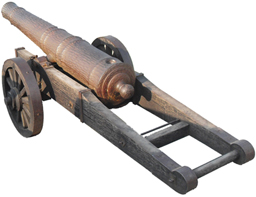
In the late 17th century, practical science was booming to correct social contradicts. The realists' idea was to build a country based on stabilization of civil life and wealthy nation. This practical science did actually achieved scholastic results. Practical science expanded its horizon into almost every imaginable fields and in the era of king Youngjo and king Jungjo was its very sun. King Jungjo established Kyujangkak (some sort of research institute) and published many useful volume of books and produced some prominent scholar such as Jung Yack yong.
In 19th century, due to young kings' succession of the throne, power of maternal relations were suppressing the royal authority. This is the beginning of the wielding power politics (Sedo Politics). This kind of abnormal concentration of political power brought about
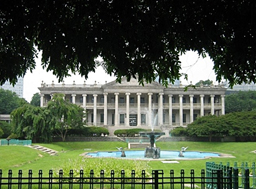
political disorder and the damage went to as far as the peasantry. Complaints of the peasantry grew bigger and bigger, finally the civil upspring did take place. Hong Kyung Rae's upspring did take place due to the discrimination treatment to local province followed by Jinju civil upspring, which occurred to eliminate fierce local bureaucrats. However, these civil upspring developed into the resistance against the corrupted ruling class and its society. Therefore these civil upspring appealed to the public.
Catholic church spread national widely with Seoul as the center. Donghak was prevailed throughout the country especially in the rural area. Both Catholic and Donghak denied the class system and Chosun's reality. Natural reaction from the government was to suppress these two movements, but regardless of the oppression, they were not to be stopped easily.
In 1863 as Kojong succeeded the throne, Kojong's father Heungsun-Daewongun seized political power. He tried to strengthen the royal authority with some radical reform policy. He tried to remove all sorts of wrong doings of the politics and restructuring the ruling system in attempt of building the wealthy and stronger nation. With the national isolation policy, he tried to defeat the invasion from the Western power. In 1876 Chosun had to open its door to the outside countries as Kojong started to rule the country for himself and accepting new modern Western civilizations. This door open was somewhat forced by foreign power and this forcefulness stimulated nationalism to defend Chosun from any outside invasion. This led to the conflict between the conservatives and enlightenment advocates. As enlightenment policy was being processed there were a lot of Japanese and western countries' senseless acquisition of concessions which led to ceaseless resistance by Chosun people.
Unfortunately, vulgar Japanese occupied Chosun by force and finally in 1910 Chosun was deprived its every rights including sovereignty and degraded to colonial province for 35 bloody years. But endless resistance were persisted. 3.1 independence movement took place in 1919, which show the spirits to strive for liberty and this triggered the establishment of temporary government in Shanghai. This enabled Korean people to keep their historical legitimacy.
The Republic of Korea
In 1945 August 15th, Japan surrendered to United Nations. This led to the end of the second world war and the end of 35 years of colonial period for Korean people. Upon independence, Korean could build up the new modern country on the basis of democracy.
Korea won their freedom back because of the United Army's victory and Korean people's ceaseless resistance against Japanese regime. Under Japanese' control, Korean continued their independence movements and established temporal government at Shanghai. However, the independence of Korea depended on UN countries, the history of Korea after the independence also had to be dependant of Western interested countries. In haste, and in an effort to stop the advance of the Russians, a line at the 38th parallel was determined to be the point beyond which Russians would not advance. The US slowly moved to take up its responsibilities of resettling Koreans returning from abroad and
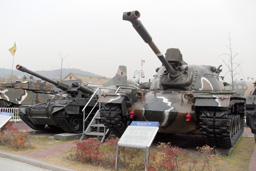
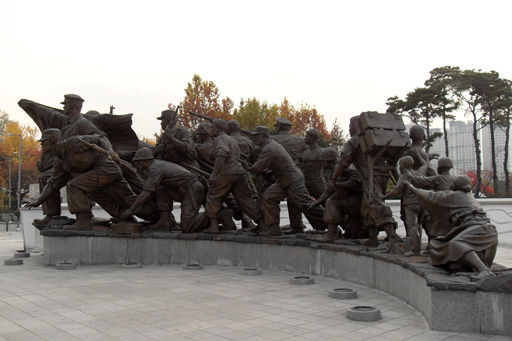
otherwise trying to develop a government for the Korean Peninsula. US, Soviet union and UK met in Moscow and decided to put Korea under a trusteeship in their care in preparation for unification. By the result of the trusteeship decision, two different government in Korean Peninsula were established.
In 1948, South Korea established the government of Republic of Korea and in the following month People's republic of Korea in North Korea was set up. On Sunday morning, June 25, 1950, the northern army struck deeply across the 38th parallel and moved into Seoul and on southward. The two sides fought on for high ground here and there along the 38th parallel until an armistice was signed on July 27, 1953. A demilitarized zone was declared and both sides continue to meet from time to time at the border village called Panmunjom. The was is not over yet.
Syngman Rhee remained President throughout the war and for several years thereafter, but corruption and economic stagnation bred discontent. Finally, with the blatant ballot box stuffing and other fraudulent election practices in the spring of 1960, demonstrations, initially led by students but soon joined by citizens from all walks life, led to the resignation of the old patriot. He left Korea and died in exile where he had spent most of his life. On May 16, 1961, a major general, Park Chung-Hee, Lt. Colonel Kim Jong-Pil led a military coup and took over the control of the government, initially leading a group of military officers in a military junta. The new government set its sights on economic development and subsequently led the country through some of the most remarkable economic growth ever seen on this planet. Korea in the 70s averaged nearly 10 percent each year. But, president Park's 18 years of long military dictatorship ended by his own men in 1979. Again two star general Chun Doo Hwan led silent coup to take over the leadership and launched the 5th Republic. The fifth republic carried out a series of social reforms and in the economic sector, registered the first-ever surplus in the balance of payments in the history of the Republic. Roh Tae Woo won the direct presidential election following the revision of the constitution. With the Sixth Republic thus launched, there was a steady transition from authoritarianism to democracy. In 1988, Korean government successfully held 24th Olympiad-Seoul Olympics game, which was the most successful of any games held to that time in terms of the number and scale of participating countries.
In 1991, South and North Korea joined the United Nation as member countries together. In a completely free and fair election in 1992, Kim youngsam became the first civilian president in 32 years. On assuming office on February 25, 1993, president Kim carried out bold reform policies to build a New Korea. Mr. Kim tried to disconnect the collusion between politics and corporations in vain. He condemned two former president for their corruption and put them in jail, but he had some bitter taste in his mouth because his own son was imprisoned for the similar charge-corruption. Due to president Kim's mis-management of the Republic, the whole country is in economic crisis at present.
In 1998, new president Mr. Kim Dae Joong launched the new government. He ironically united with Kim Jong-pli who was political enemy of Kim dae Joong for more than 30 years. President Kim's new government has historical meaning of switching power from long time ministerial party to opposition party. The new government of Korea is facing many problems to solve. The main task of this new government is to overcome the crisis and marching toward new 21st century.
the border village called Panmunjom. The was is not over yet.
Syngman Rhee remained President throughout the war and for several years thereafter, but corruption and economic stagnation bred discontent. Finally, with the blatant ballot box stuffing and other fraudulent election practices in the spring of 1960, demonstrations, initially led by students but soon joined by citizens from all walks life, led to the resignation of the old patriot. He left Korea and died in exile where he had spent most of his life. On May 16, 1961, a major general, Park Chung-Hee, Lt. Colonel Kim Jong-Pil led a military coup and took over the control of the government, initially leading a group of military officers in a military junta. The new government set its sights on economic development and subsequently led the country through some of the most remarkable economic growth ever seen on this planet. Korea in the 70s averaged nearly 10 percent each year. But, president Park's 18 years of long military dictatorship ended by his own men in 1979. Again two star general Chun Doo Hwan led silent coup to take over the leadership and launched the 5th Republic. The fifth republic carried out a series of social reforms and in the economic sector, registered the first-ever surplus in the balance of payments in the history of the Republic. Roh Tae Woo won the direct presidential election following the revision of the constitution. With the Sixth Republic thus launched, there was a steady transition from authoritarianism to democracy. In 1988, Korean government successfully held 24th Olympiad-Seoul Olympics game, which was the most successful of any games held to that time in terms of the number and scale of participating countries.
In 1991, South and North Korea joined the United Nation as member countries together. In a completely free and fair election in 1992, Kim youngsam became the first civilian president in 32 years. On assuming office on February 25, 1993, president Kim carried out bold reform policies to build a New Korea. Mr. Kim tried to disconnect the collusion between politics and corporations in vain. He condemned two former president for their corruption and put them in jail, but he had some bitter taste in his mouth because his own son was imprisoned for the similar charge-corruption. Due to president Kim's mis-management of the Republic, the whole country is in economic crisis at present.
In 1998, new president Mr. Kim Dae Joong launched the new government. He ironically united with Kim Jong-pli who was political enemy of Kim dae Joong for more than 30 years. President Kim's new government has historical meaning of switching power from long time ministerial party to opposition party. The new government of Korea is facing many problems to solve. The main task of this new government is to overcome the crisis and marching toward new 21st century.

